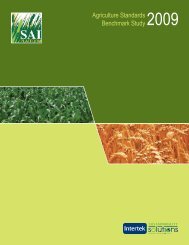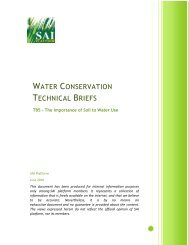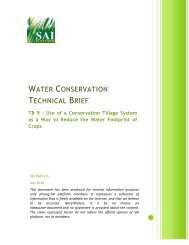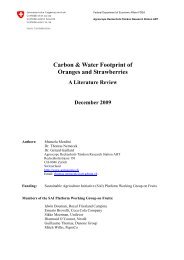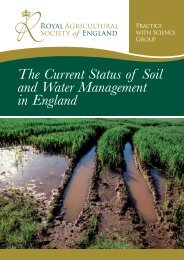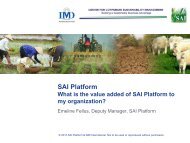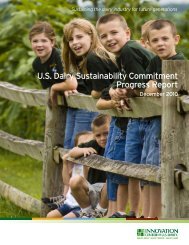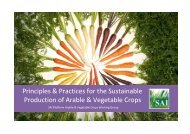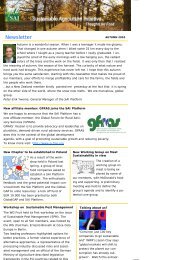Agriculture, food and water - FAO.org
Agriculture, food and water - FAO.org
Agriculture, food and water - FAO.org
You also want an ePaper? Increase the reach of your titles
YUMPU automatically turns print PDFs into web optimized ePapers that Google loves.
AGRICULTURE, FOOD AND WATER<br />
39<br />
have tended to be only half-hearted when enacting complementary policies <strong>and</strong> institutional<br />
reforms that are necessary to provide the appropriate environment for effective operation of<br />
the new irrigation management entities. The process of empowering marginalized stakeholders,<br />
including smallholders, <strong>and</strong> evicting political influence from irrigation management, is as yet not<br />
completed. Irrigation management transfer is complicated because of a number of factors. Firstly<br />
there is a need to promote poor stakeholders into equity with non-poor stakeholders <strong>and</strong> reconcile<br />
conflict between upstream <strong>and</strong> downstream users. Secondly, the transaction costs of <strong>water</strong>-user<br />
associations may be higher than under properly working ‘comm<strong>and</strong> <strong>and</strong> control’ management<br />
establishments. Finally, the apportionment of financial <strong>and</strong> operation risk <strong>and</strong> liability is difficult<br />
to make when a large-scale infrastructure is transferred to user associations or service companies<br />
not prepared for such responsibilities.<br />
Equity in the roles of men <strong>and</strong> women in irrigation<br />
Gender equity is a case in point. Women are among the main stakeholders in poverty alleviation,<br />
in <strong>food</strong> production in irrigated <strong>and</strong> non-irrigated agriculture, <strong>and</strong> in ensuring <strong>and</strong> dispensing<br />
nutrition at the household level. A majority of the poor, estimated at 70 percent, are rural<br />
people, <strong>and</strong> rural poverty has become feminized as men of productive age migrate away from<br />
impoverished rural areas to the more promising urban environment, or are forcibly recruited by<br />
warring factions, leaving behind the women, the elderly, the sick <strong>and</strong> the children. In rural areas<br />
endemically stricken by conflicts, whatever little infrastructure there was collapses or is wantonly<br />
destroyed <strong>and</strong> insecurity prevails, increasing the burden on women. Households headed by<br />
women are recognized among the poorest of the poor. Against a biased view that ‘women do not<br />
irrigate’, women are now recognized as actively involved in irrigation, often demonstrating high<br />
levels of skill (see Box 8).<br />
BOX 6 LAND OWNERSHIP AND ECONOMIC INDEPENDENCE<br />
A recent study in Dakiri, Burkina Faso, shows that allocating smaller plots to men <strong>and</strong> women<br />
separately instead of allocating larger plots to household heads has produced both higher yields<br />
<strong>and</strong> social benefits. When both men <strong>and</strong> women have irrigated plots, the productivity of irrigated<br />
l<strong>and</strong> <strong>and</strong> labour is higher than in households where only men have plots. Women are equally<br />
good or even better irrigation farmers than men, <strong>and</strong> those who have obtained irrigated plots are<br />
proud of their increased ability to contribute to the needs of their households. Women prefer to<br />
contribute to their households by working on their own plots rather than providing additional<br />
labour to their spouse’s or to the collective plots. As they become economically less dependent<br />
upon their husb<strong>and</strong>s, they can help support their relatives <strong>and</strong> increase their own opportunities for<br />
individual accumulation of wealth in the form of livestock. The effects of having an individual plot<br />
significantly improve the bargaining position of a woman within a household <strong>and</strong> are a source of<br />
pride in the household <strong>and</strong> the community.<br />
Source: OECD/DAC, 1998.



